(part 2)
"Truth shall spring out of the earth" (Ps. 85:11).
"It may be stated categorically that no archaeological discovery has ever controverted a Biblical reference. Scores of archaeological findings have been made which confirm in clear outline or exact detail historical statements in the Bible. And, by the same token, proper evaluation of Biblical descriptions has often led to amazing discoveries." (Glueck, Nelson (1959). Rivers in the Desert. p. 136.)
The Historical Accuracy of Abraham's Family Customs
Abraham was born in Ur of the Chaldeans. Since the Chaldeans did not appear in southern Mesopotamia until many centuries later, however, the phrase "of the Chaldeans" in Genesis 11:28 is understood to be a later scribal addition supplied to distinguish Abraham's Ur from other cities carrying the same name. Solomon began to reign about 970 B.C. It is stated in 1 Kings 6:1 that the Exodus took place 480 years before the fourth year of Solomon's reign, or about 1446 B.C. Exodus 12:40-41 begins the sojourning of the patriarchs in Canaan and Egypt 430 years earlier -- about 1876 -- when Abraham was first given the covenant (Gal. 3:16-17). From a study of Genesis 12:4; 21:5; 25:26; and 47:9 it is inferred that the patriarchs sojourned in Canaan 215 years, entering about 2091. Since Abraham was 75 when he entered Canaan, his birth would be pegged at 2166 B.C. In these references it is clear that Abraham entered Canaan at 75. Isaac was born to him at 100. Isaac was 60 at Jacob's birth. Jacob was 130 when he stood before Pharaoh. A total of 215 years elapsed, then, between Abraham's entrance into Canaan and Jacob's entrance into Egypt.
Cyrus Gordon feels that the Hebrew patriarchs fit the general context of merchant activity indicated by Ugarit literature. They were merchants. For instance, Joseph told his brethren that if they could prove their honest intentions, they would be permitted to TRADE in the land (Gen. 42:34). The Shechemites gave permission to Jacob's household to "dwell and TRADE" and "acquire real estate" in their territory (Gen. 34:10). In Genesis 23 Abraham was permitted to buy land with shekels of silver -- called "current money with the MERCHANT" (v.16). Genesis 13:2 and 24:35 mention that Abraham was rich in gold and silver.
A. How Did Abraham Buy The Cave of Machpelah?
The story of Abraham's purchase of the cave of Machpelah as a burial site for Sarah his wife (Gen. 22) gives us information about many customs relating to land purchases. As a foreigner or landless resident alien, Abraham was required to approach the local citizens or sons of Heth (cf. Gen. 10:15) -- Anatolian Hittites with a settlement in Canaan. Exaggerated politeness ("I give you ...") and protracted negotiations which are characteristic of oriental business dealings then took place, as was normal, at the city gate -- the legal center (Gen. 23:10). Abraham wanted only the cave, but he was obliged finally to take the whole field. The price was fixed at 400 pieces of silver -- a mere pitance they said (v. 15), but in reality price-gouging andfar above market value. (cp Jer 32:9, where Jeremiah buys a field for seventeen shekels of silver and compare 2 Sam. 24:18 where David paid Araunah 50 shekels of silver for the threshingfloor and the animals.) But he did not complain. This is the attitude of a sojourner in a foreign land. He accepts the customs of the land if they do not violate the principles of his beliefs. Was Abraham using "all that he had" to buy the field, namely a stake in the promised land? And is this what Jesus is commenting on in Matt 13:44? Was Sarah, his wife, Abraham's greatest treasure?). The landowner drove a hard bargain when he found someone in desperate need. The silver was weighed out on simple scale pans, presumably according to the current standard weights used by the merchants or "current money with the merchants" (Hittite phrase) (v.16). The area in question was carefully defined: "all the trees in the field" since the validity of a land contract depended on mentioning all the trees and their locations (v.17) and finally recognized as Abraham's property by the citizens, and Sarah was buried.
This story has many general characteristics in common with Near Eastern legal procedures from many periods. The phrase "for the full price" (v.9), which also occurs in the account of David's purchase of the threshing floor (1 Chr. 21:23-24) is the equivalent of an expression which occurs with slight variations in Akkadian sale contracts from several periods. It runs back even to Sumerian times. The expression occurs in the Mari Texts and the Alalakh tablets, as well as in later texts, to denote that the complete price had been paid, with no balance remaining. What Abraham was saying was that he would give the full value of the field, he would buy it. This was a well-known legal formula. As in most ancient Near East deeds, the exact price of the sale is mentioned (v.16) and the account of the transfer includes a description of the property (v.17) in terms of the type of real estate (field), the name of the landlord, the general location (Machpelah), and the appurtenances of the land (cave and trees). However, the story of Genesis 23 does not mention guarantee clauses or provisions against suit, supported often by penalties. No list of witnesses is given, although this may be implied by the phrase "in the presence of the sons of Heth before all who went in at the gate of his city." The style, structure, formulae and contents of certain parts of the report are modeled on deeds of sale well known in the ancient Near East.
A Hittite law dating several centuries after Abraham states: "If anyone buys all the fields of a craftsman, they shall ask the king, and the buyer shall render those services which the king orders. If there remain fields in the hands of the man from whom he buys, the buyer shall not render the services" (ANET 191). In this Hittite law, the obligation to perform services was conferred on the buyer only when all the seller's property was passed on to the new owner. If Abraham buys the whole field, he is liable for the tax burden and must supply soldiers for the defense of the town. Abraham was trying to remain separate and avoid ties to this society. Abraham asked for only the cave, but Ephron wanted to sell both the cave and adjoining field. The issue was who would be responsible for the service. By deeding the field and the cave to Abraham, Ephron freed himself from this service.
B. God's Promise To Abraham Of a Son
God made it clear that Eliezer was not Abraham's heir in Genesis 15 where we find a king subject type of covenant between God and Abraham. In the ceremony it was necessary to cut the animal in half and shed its blood. The Hebrew verb for making a covenant is literally "to cut" a covenant. The pieces of the animals would be placed in two rows with an aisle between. The parties to the covenant walked between the rows while taking an oath invoking similar dismemberment on eachother should they not keep their part of the covenant. This ceremony differs, however from all other known examples in that God alone walked between the rows of animal pieces and took the oath only on himself.
C. Why Didn't Eliezer Become Abraham's Heir?
An ancient site southeast of Nineveh not far from modern Kirkuk is Nuzu. Several thousand tablets have been excavated here which provide numerous illustrations of customs of the patriarchs. Nuzi was excavated between 1925 and 1931. The clay tablets date to the fifteenth century. At Nuzi a childless couple frequently adopted a freeborn person or a slave to look after them when they grew old, bury them when they died, mourn for them and inherit their property. Abraham who had no prospect of any children of his own, refers to Eliezer of Damascus as his heir, and calls him "son of my house," that is, his heir presumptive (Gen. 15:2). Presumably Abraham had legally adopted this trusted slave in accordance with prevailing custom, as a "legal fiction" to the mutual advantage of both, since a man was not supposed to alienate ancestral property. But God said, "This man shall not be thine heir" (Gen. 15:4). If he was a legally adopted heir, how could his rights be set aside as long as he fulfilled his filial duties? The Nuzi texts give the answer. There a provision is made that if the adopter should afterward beget a son of his own, the adopted son must yield to him the place of the chief heir.
"The tablet of adoption belonging to Nashwi, the son of Ar-shenni: he adopted Wullu, the son of Puhi-shenni. As long as Nashwi is alive, Wullu shall provide food and clothing; when Nashwi dies, Wullu shall become the heir. If Nashwi has a son of his own, he shall divide the estate equally with Wullu, but the son of Nashwi shall take the gods of Nashwi. However, if Nashwi does not have a son of his own, then Wullu shall take the gods of Nashwi. Furthermore, he gave his daughter Nuhuya in marriage to Wullu, and if Wullu takes another wife he shall forfeit the lands and buildings of Nashwi. Whoever defaults shall make compensation with one mina of silver and one mina of gold." -- Nuzi sale adoption tablet.
Incidentally, this is why Laban threatened Jacob by saying in Genesis 31:50, "if thou shalt take other wives beside my daughters ... see, God is witness between and thee." This was a prohibition regularly found in marriage contracts.
D. Why Did Sarah Give Hagar To Abraham?
Nuzi marital customs illustrate Sarah's action in giving her Egyptian servant Hagar to her husband as her substitute when she was unable to become a mother herself (Gen. 16:1-16). Later Rachel followed the same course with her servant Bilhah and her example is followed by Leah, but for a different reason (Gen. 30:3,9). Eliezer also was a servant "born in my house " who "is my (Abraham's) heir" (serugate son) (Gen. 15:3). Nuzi marriage regulations stipulate that if a wife is barren, she must furnish her husband with a slave wife. Six Nuzi marriage contracts make provision for the husband to marry a second wife if the first is barren, and four imply that the husband could raised up offspring through his concubine if his wife is barren. For example: "If Gilimninu (the bride) will not bear children, Gilimninu shall take a woman of N/Lullu-land (where the best slaves were obtained) for Shennima (the groom) ... Gilimninu shall not send the (handmaid's) offspring away" (C. Gordon's Biblical Customs and the Nuzu Tablets). But Sarah nevertheless wanted Hagar and Ishmael sent away since Ishmael had made fun of Isaac (Gen. 21:9). But it was "very grievous" to Abraham since it violated the Nuzu law codes. Only God's intervention convinced Abraham to comply with Sarah's demand over the Nuzu law code.
Later, when Sarah had herself given birth to Isaac, and demanded that Hagar and her child should be expelled and disinherited, Abraham's reluctance to comply is readily understandable in the light of common practice at Nuzi. There the law provides that in the event the slave wife should bear a son, that son must not be expelled. It is clear that Sarah's demand was illegal according to Nuzi, and Abraham would have refused to expel the son if God had not told him to do so.
E. Could Esau Legally Sell His Birthright?
Esau's sale of his birthright (Gen. 25:27-34) for a bowl of soup has a parallel. At Nuzi a legal arrangement existed whereby the privileges of the firstborn were transferred to another. In one instance they were transferred to one who was not actually a brother, but who was adopted as a brother. In another case actual brothers were involved and the one who surrendered his rights received three sheep in return. For instance: "On the day they divide the grove (that lies) on the road of the town of Lumti ..., Tupkitilla shall give it to Kurpazah as his inheritance share. And Kurpazah has taken three sheep to Tupkitilla in exchange for his inheritance share" (C. Gordon 1940:5).
F. Why Did Rachel Steal Laban's Idols?
Rachel's theft of Laban's teraphim gods (Gen. 31:34) is much better understood in the light of Nuzi evidence. Laban adopted Jacob as his son. When Jacob married a daughter of his foster parent Laban, Jacob's wives, children and flocks became Laban's as long as Laban the Patriarch lived (Gen. 31:28, 43). Jacob never established his own independent household in all the 40 years he was with Laban because Laban was the true owner and only household authority as Patriarch. Laban apparently had no sons when Jacob first arrived, but later on Laban had sons of his own and "his countenance ... was not toward" Jacob "as before" (Gen. 31:1). This development changed the legal situation for Jacob and his wives. Therefore, Jacob fled away secretly (31:19-20) and his wives agreed to go with him saying "Is there yet any portion or inheritance for us in our father's house?" (31:14). You don't leave without parental permission even if married. (Recall that the sons of Keturah were sent away Evidently the possession of these household gods implied leadership of the Patriarchal family and in the case of a married daughter assured her husband the right to inherit the property of her father Laban. Since Laban had sons of his own when Jacob left for Canaan, they alone had the right to their father's gods, and the theft of these household idols by Rachel was a serious offense (Gen. 31:19, 30,35) aimed at preserving for her husband the chief title to Laban's estate. Jacob buried the images at Shechem without making use of them (Gen. 35:2-4). This also illustrates that Laban's household had been corrupted in their religion.
It was also customary, according to the Nuzi text, to give a handmaid as part of the dowry to each daughter who was given in marriage, just as Jacob received a handmaid with each one of his wives as Laban's gift (Gen. 29:24,29).
Jacob later admitted, "Rachel died because of me" (Gen. 48:7) (because of his vow: "With whomsoever you find your gods, let him not live" (Gen 31:32).
G. Did Laban Cheat Jacob?
Jacob described his experience with Laban this way: "These twenty years I have been with you; your ewes and your female goats have not miscarried, nor have I eaten the rams of your flocks. That which was torn of beasts I did not bring to you; I BORE theLOSS of it MYSELF. YOU REQUIRED IT of my hand whether stolen by day or stolen at night" (Gen. 31:38-39). Is Jacob complaining that Laban cheated him?
The Code of Hammurabi, 1750 B.C., contains a law that seems say just that: "If a visitation of god has occurred in a sheepfold or a lion has made a kill, the shepherd shall prove himself innocent in the presence of god (take an oath?), but the OWNER of the sheepfold shall RECEIVE from him the STRICKEN in the fold" (ANE 1:166; ANET 177).
Furthermore, Laban changed Jacob's wages TEN times (Gen. 31:41).
H. Why Did Jacob Bow Seven Times?
As Jacob approached his brother, he bowed to the ground seven times, reflecting the customary bowing done in the presence of a superior. It is used repreatedly in the Amarna Letters. For example, Biridiya wrote to the pharaoh (ANE 1:263; ANET 485): "To the king, my lord, and my Sun-god, say: Thus Biridiya, the faithful servant of the king. At the two feet of the king, my lord, and my Sun-god, seven and seven times I fall."
From the Invasion of the Hyksos Shepherd Kings (1957 BC) to the Expulsion of Israelite Shepherds (1446 BC) (Their Supposed Descendants)
Manetho Reckoned 511 Years (2nd & 3rd Dynasties) (Against Apion 1:14)
A few centuries before the Israelites went down to Egypt, an Asiatic people, the HYKSOS, ("foreign rulers" or "shepherd kings" -- Against Apion 1:14) took advantage of the unsettled political condition in Egypt, and seized the throne. Psalm 78:49 mentions this invasion of "king-shepherds" or "mishlakhat malkhei-roim" against Egypt but the text has been corrupted to read "evil angels" or "mishlakhat malakhei-roim" instead. This is contrary to proper Hebrew grammar. If "evil angels" were the correct reading, then the Hebrew should be "malakhim raoth." They were Arabians (Against Apion 1:52). Specifically Amalekites (pp. 64-65, Ages in Chaos). Their king Agag (Nu. 24:7) was known as Apop (Manetho). (They settled in the northern Delta region of Egypt, making their capitol at Avaris.They were somewhat akin to the Israelites and the HYKSOS Pharaoh treated Israelites kindly as long as he reigned. This is why Joseph coached his brethren before they were introduced to Pharaoh. Joseph told them to profess to be shepherds "For every shepherd is an abomination unto the Egyptians" (Gen. 46:34). Why? "That ye may dwell in the land of Goshen" where Pharaoh dwells, a land of cattle and sheep, "the best of the land" (47:6). Therefore there would be no objection from the Egyptians. Pharaoh also had cattle (47:6). Thus we know that the Pharaoh who was in Egypt was not an Egyptian but an Asiatic HYKSOS, a king who did not favor the Egyptians. To any native king, a shepherd would be an abomination, but not to the HYKSOS, for they, too, were shepherds.
Manetho wrote an account of the HYKSOS preserved in Josephus: “…for what cause I know not, a blast of God smote us; and unexpectedly, from the regions of the East, invaders of obscure race marched in confidence of victory against our land. By main force they easily seized it without striking a blow, and having overpowered the rulers of the land, they burned our cities ruthlessly, razed to the ground the temples of the gods, and treated all the natives with a cruel hostility, massacring some and leading into slavery the wives and children of others. Finally they appointed a king of one of their number whose name was Salatis. He had his seat at Memphis, levying tribute from Upper and Lower Egypt, and always leaving garrisons behind in the most advantageous positions.” (Flavius Josephus, Against Apion, book I, chapter 14, parts 73-92).The name “Salatis” comes from a Semitic root meaning “prince”. It is the root word of “SULTAN”. These invaders came from the East and must have passed to Egypt from the Sinai. They made Egyptians, slaves. The Bible records a people who suddenly gained prominence in that part of the world – the Edomite Amalekites (Amalek was a son of Edom or Esau). As late as the days of Saul, the Egyptians were still subject to these people: “And they found an Egyptian in the field…And David said unto him, To whom belongest thou? And whence are thou? And he said, I am a young man of Egypt, servant to an AMALEKITE; and my master left me, because three days ago I fell sick.” (I Samuel 30:11-13).The Amalekites seized the Delta after the Exodus. They are mentioned in the Bible around the time of Moses in the words of Balaam: “Amalek the first of the nations; but his latter end shall be that he perish forever.” (Numbers 24:20). “First of the nations” refers to their position and ranking at that time, since they were not great in earlier times (their forbearer was Esau) like the Bablylonians, Assyrians, and Egyptians. Also, the first people to attack the children of Israel in Sinai after the Red Sea crossing were the Amalekites: “Then came Amalek, and fought with Israel in Rephidim” (Exodus 17:8).
During part of Israel's stay in Egypt she was favored with the choicest land called Goshen for pasturing flocks and herds and Joseph was put upon the throne as prime minister. When the famine increased, there is no indication the Israelites were forced to mortgage their lands, sell their flocks or sell themselves as slaves. They were favored in Egypt. But the tables were turned and Israel became oppressed. How? Exodus 1:8 says, "There arose up a new king over Egypt, which knew not Joseph." He was a native Egyptian, the founder of the eighteenth dynasty who expelled the HYKSOS. His name was Amosis I (c. 1570-1545) who stormed Tanis (Zoan) and destroyed the last Semitic garrisons in Egypt about 1550 B.C. including Avaris. This native Egyptian feared lest the Israelites might multiply and some day do as the HYKSOS did and seize the throne. This accounts for their enslavement and persecution. The HYKSOS included Hebrews (Apiru) and Arameans (Amurru) and others -- a "mixed multitude." Manetho recorded that these HYKSOS later went to JUDEA and built JERUSALEM after leaving Egypt (Josephus, Against Apion 1:14). Ezekiel 16:3 says that Jerusalem was built by "an Amorite , and ... an Hittite." Therefore we know the HYKSOS included Amorites and Hittites as well as Hebrews and Arameans. The Hyksos had Canaanite names.
The powerful 18th Dynasty was founded by Amenhotep I (1546–1525 B.C.), who came to power after the Hyksos campaign. Remaining Semites who stayed behind after the Hyksos were driven out were treated brutally by the next several kings (Thutmose I and Thutmose II), culminating in Thutmose III, who “…made their lives bitter with hard bondage, in mortar, and in brick, and in all manner of service in the field…” (Exodus 1:14). Thutmose III was known as “the Napoleon of Egypt”, and who set about conquering large swaths of territory once occupied by the Hyksos and their allies. He was also a great builder who used many slaves in his building projects; the population of slaves included large numbers of Semites, who were hated by Thutmose as a result of the Hyksos period. Archaeologist and historian W.F. Albright confirmed that the Hyksos invasion of Egypt was led by a Semitic people, not Hurrians or Indo-Aryans as some scholars contend; the fact that the remaining population was Semitic help fuel the hatred that many Egyptians felt for the Hebrew slaves remaining in Goshen.
Rekhmire, the vizier to Thutmose III, left behind splended wall paintings in his tomb in which scenes of the making of bricks and other tasks are being carried out, similar to the scene in Exodus 5:6–19. Found among the figures in the paintings are Semitic foreigners engaged in brick-making, with the hyroglyphic text having them say “He supplies us with bread, beer, and every good thing,” while they get a stern warning from the task-masters: "The rod is in my hand; be not idle!"
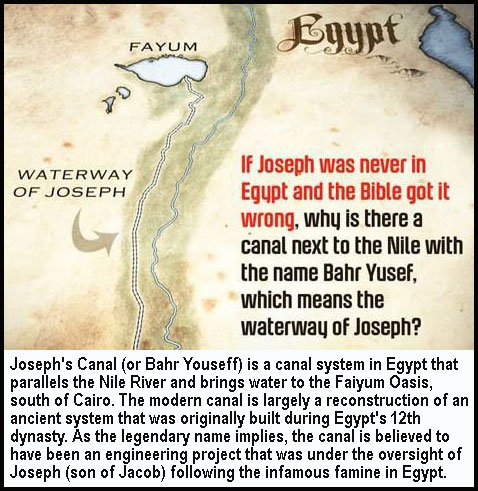
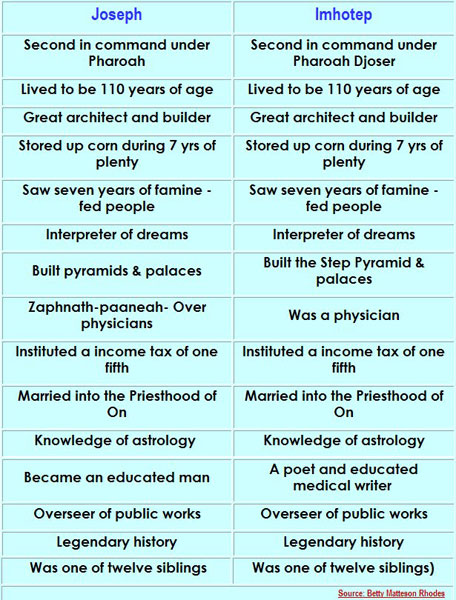
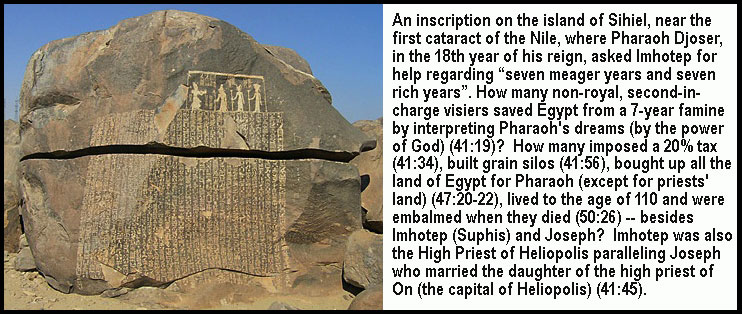
Is There Any Proof that Joseph Existed?
Joseph was elevated to regal dignity in Egypt under Apepi II, last of the Hyksos Pharaohs. Joseph was of the same race as the Pharaoh. More importantly, the High Priests in Egypt were always Princes and so we have Potiphera, Prince or Priest of On, a Semitic office under the Hyksos. His daughter, Asenath, was given in marriage to Joseph, and became the mother of Ephraim and Manasseh. It is commonly believed that Asenath was an Egyptian. This is not so. The name Asenath is of Hebrew origin.
But is there any evidence that Joseph existed? The main canal that links Lake Moeris in the Faiyum with the Nile, and ensures the fertility of the oasis, is the Bahr Yusuf, the "Canal of Joseph"; for the Arabs believe that the ancient reservoir of Pharaonic times was the work of the Biblical Joseph, in Arab legend the " Grand Vizier " of Pharaoh.
Near Lake Moeris the King had a great "Labyrinth" built. It was an immense structure spreading over many acres. It served as general headquarters for the government and as a center of administration for the distribution of government provisions -- the 20% that was collected during the years of plenty to be used in the years of famine.
What about the record of a FAMINE for 7 long years? From a Third Dynasty text in the reign of King Zoser, the builder of the famous step pyramid, we read, "My heart is in great anxiety, for in my time the Nile has not overflowed for a period of SEVEN YEARS. There is scarcely any produce of the field; herbage fails; eatables are wanting. Every man robs his neighbor ... the children cry, the young people creep along ... the people of the courts are at their wits' end. The store-houses were built, but ... all that was in them has been consumed," he laments (from Barton's "Archaeology and the Bible", pp. 370-371). Compare this with Genesis 41:29-32 and 47:13-27.
How Many Israelites Entered Egypt?
Genesis 46:26-27 and Acts 7:14 give three different totals for the number of people entering Egypt. Did Stephen contradict Moses regarding the number of people who moved to Egypt? Stephen referred to the number of Jacob’s family members that moved down to Egypt as 75 (Acts 7:14). Yet in Genesis 46:27, Moses recorded the number as 70. Critics of the Bible claim to have found a discrepancy. If they would have only studied the matter a little more closely, they would have seen that Moses and Stephen were simply approaching the matter from different perspectives. Genesis 46:26 numbers Jacob’s children, grandchildren, and great-grandchildren as 66. To that number, which does not include Jacob’s son’s wives, Moses added Jacob, Joseph, and Joseph’s two sons to arrive at the number 70. Stephen, on the other hand, did not include Joseph and his wife and two sons since they were already in Egypt and Joseph is mentioned as sending for Jacob and the relatives from Egypt. Stephen names Jacob separately from the 75 relatives. Thus Stephen’s number includes the 66 mentioned in Genesis 46:26 plus the nine wives of Jacob’s sons (Judah’s and Simeon’s wives being already deceased). The Bible harmonizes perfectly and there is no discrepancy.
How Do We Count 400 Years?
Gen. 15:13:The sojourning of Abraham's descendants (from the call of their ancestor) was 400 years (including Abraham's own sojourning: Heb 11:8,9). From call of Abraham to birth of Isaac = 25 years (Gen 12:4; 21:5). Isaac at 5 years was mocked by Ishmael (Gen 21:8,9). Affliction begins, and 400 years begin (Gal 4:29). Thus 430 - 30 = 400 years sojourning of Abraham's seed: cp Exo 12:40; Act 7:6; Gal 3 :16,17. (The 400-year affliction of Abraham's seed begins in Gen. 21:8: cp Gen 15:13n; Gal 4:24. Ages: Ishmael 18 or 19, Isaac 5. See Gen 13:5).
Do We Find Bricks of Clay Without Straw?
The bricks of Pithom in Egypt found by Naville (1883) and Kyle (1908) confirm Ex. 5:7-18. The lower courses of bricks found at Pithom, are filled with good chopped straw; the middle courses with less straw, and that was stubble plucked up by the root; and the upper courses of brick were of pure clay, having no straw whatsoever. On Rekhmire's tomb the brickmakers are depicted. The taskmasters warn the laborers, "The rod is in my hand; be not idle" (J.H. Breasted, Ancient Records of Egypt 2:758).
Who Was The Pharaoh Of The Exodus?
Diodorus Siculus (1st cent. B.C.), gave evidence for the truth of the Bible’s Exodus account. Of the Hebrews, he said, “Their forefathers had been banished out of the whole of Egypt... in order to purify the land.” (The History Of Antiquity, p.458) There was some truth to this assertion, after Egypt had endured the horrible swarms of insects and pestilential diseases of the ten plagues! Early Greek geographer and historian, Strabo (born 63 B.C.), also lent support to the Biblical account, saying, “Moses told them and taught that the Egyptians were not right in representing the divinity as a wild or domesticated animal, nor the Libyans, nor were the Hellenes wise in giving gods the form of men. For only the One was God which surrounds us all... By such doctrines Moses convinced not a few men of reason, and led them to the place where Jerusalem now is.” (ibid., p. 459)
Most modern scholars think the Pharaoh of the Exodus was Raamses II making the Exodus occur about 1270 B.C. This is because Exodus 1:11 mentions a city built by Israelites called "Raamses" and the assumption is that he had to reign before they built a city named after him. But it could have been a later revision by Samuel. Genesis 47:11 says, "in the land of Rameses" which represents another later revision. The same is true of the other city named "Pithom" or "the abode of Thom" -- the King Thom who reigned 600 years later.
However, 1 Kings 6:1 declares that it was 480 years before the fourth year of Solomon's reign (which was about 967 B.C.). This would place the Exodus around 1447 B.C. This fits also with Judges 11:26 which affirms that Israel spent 300 years in the land up to the time of Jepthah (which was about 1000 B.C.). Likewise Acts 13:20 speaks of there being 450 years of judges from Moses to Samuel who lived around 1000 B.C. The same is true of the 430 years mentioned in Galatians 3:17 spanning from around 1800 to 1450 B.C. (from Jacob to Moses). The same figure is used in Exodus 12:40. All of these passages provide a 1447 B.C. date, not a 1270 B.C. date. If we accept the traditional account of the reigns of the Pharaohs, the Pharaoh of the Exodus was Amenhotep II who reigned from about 1450 to 1425 B.C.
Syncellus preserves the record that in the fourth year of Apophis I, Joseph came as a slave into Egypt. During the 17th century, B.C. Egypt was ruled by the Hyksos. These Semitic intruders, according to archaeological evidence, introduced the horse and chariot into Egypt, which are mentioned in the Bible for the first time in the story of Joseph (Gen. 47:17; 41:43). Joseph, a Semite, would be on friendly terms with another Semite as a number two man serving this Hyksos king. The "new king over Egypt, who knew not Joseph" (Ex. 1:8) was Pharaoh Ahmose (1580-1546 B.C.), who began dynasty 18, who liberated it from the Hyksos. Hebrew hardships came during the rule of Amenhotep I (1546-1525 B.C.) or Thutmose I (1525-1508 B.C.) as the Egyptians remembered Hebrew friendship with the Hyksos. Now Moses was born "fourscore" years before the Exodus (Ex.7:7) or 1527 B.C. He was raised by "the daughter of Pharaoh" (Ex.2:5), who was known as "Queen Hatshepsut" who married her brother named Thutmose II. But when Hatshepsut couldn't produce a male heir to the throne, her brother/husband chose a non-royal mistress named Isis to produce a male heir and named their son Thutmose III. Hatshepsut raised the boy as her own son even though Isis was his real birth mother. She was the daughter of Pharaoh Thutmose I, the grand son-in-law of Ahmose. Moses fled from Thutmose III (c.1482-1450 B.C.), the pharaoh of the oppression (Ex. 2:23), who had been pushed aside by his aunt and step-mother Hatshepsut. Once pharaoh, he organized military campaigns and fought the enemies of the Hyksos who had settled in Canaan. After his famous battle of Megiddo in Canaan in 1479 B.C., he installed district governors in garrison cities throughout Canaan. Amenhotep II (c.1450-1425 B.C.) was the arrogant and haughty pharaoh of the Exodus (Ex.7). The suffix "MOSE" means "SON" (p.115, Keller's Bible As History). Thutmose and Ahmose were sons of Thut (scribal god) and Ah (moon god). But nobody knew who the father of MOSE was, so he was just called MOSES. Or perhaps Moses' name had a prefix like the others (Hatshepsutmose) but Moses "refused to be called the son of Pharaoh's daughter" (Heb.11:24).
Once again, the pharaoh who refused to allow the Hebrews to leave was Amenhotep II, who reigned c. 1450–1425 B.C. He was the son of the empire builder and conqueror Thutmose III, and Amenhotep lived off his father’s largesse. It is also clear from Egyptian inscriptions that the son who succeeded him to the throne, Thutmose IV (1425-1412 B.C.), was not his first born, not the legal heir to the throne (The eldest son was killed in the tenth plague -- Ex.12:29); this was indicated by the inscription on an immense slab of red granite near the sphinx at Gizeh known as the Dream Stele at the foot of the Great Sphinx which states that while yet a youth the future Pharaoh had fallen asleep under the famous monument and dreamed. In his dream the god Amun promised to give him the throne if he cleared away the sand from the feet of the Sphinx and restore it:
“One of those days it came to pass that the king’s son, Thutmose, came, coursing at the time of midday, and he rested in the shadow of this great god. A vision of sleep seized him at the hour (when) the sun was in the zenith, and he found the majesty of this revered god speaking with his own mouth, as a father speaks with his son, saying:”Behold thou me! See thou me! My son Thutmose. I am thy father, Harmakhis-Khepri-Re-Atum, who will give to thee my kingdom on earth at the head of the living. Thou shalt wear the white crown and the red crown upon the throne of Keb, the hereditary prince. The land shall be thine in its length and breadth, that which the eye of the All-Lord shines upon. The food of the Two Lands shall be thine, the great tribute of all countries, the duration of a long period of years."
A BLACK GRANITE SHRINE found at EL-ARISH on the border of Egypt and Palestine bears a long inscription in hieroglyphics. It says, "The land was in great affliction. Evil fell on this earth.... Nobody could leave the palace during nine days, and during these NINE DAYS of upheaval there was such a tempest that neither men nor gods (royalty) could SEE the faces of those beside them." Exodus 10:22 mentions a "THICK DARKNESS" for "THREE DAYS," so perhaps there was a thin darkness for six days after the first three. Then, after a hurricane, the pharaoh chases after the "evil-doers" to "the place called "PI-KHIROTI" which agrees with Exodus 14:9 where we read that "the Egyptians pursued after them ... and overtook them encamping by the sea, beside PI-HAHIROTH." Then the death of the pharaoh is described: "His Majesty leapt into the place of the whirlpool" (cp. Ex.15:19). He was "lifted by a great force."
The AMARNA TABLETS, (c.1400-1366 B.C.) , written to Amenhotep III and IV, urging help from Pharaoh, mention upheaval caused by the "Habiru" (Hebrews) and prove that Egypt was very weak at the time when the "Habiru" were taking over Palestine (Joshua's conquest). John Bimson and David Livingston have proposed a revision of the traditional dating of the end of the Middle Bronze Age and the beginning of the Late Bronze Age from 1550 to shortly before 1400 B.C. The Middle Bronze Age was characterized by large fortified cities, a description which fits well with the account which the spies brought back to Moses (Deut. 1:28). This would mean that a conquest of Canaan that took place about 1407 B.C., allowing for 40 years of wandering in the desert, would be in complete agreement with their revised dating. "The Habiri are capturing our fortresses; they are taking our cities; they are destroying our rulers. They are plundering all the country of the king. May the king send soldiers quickly. If no troops come this year the whole country is lost to the king."
The IPUWER PAPYRUS was discovered in Memphis Egypt and is dated around the time of the 19th dynasty (The Exodus occurred at the end of the 18th dynasty in 1446 B.C.). Translated by A.H. Gardiner in 1909 from a Hieratic papyrus now in Leiden, Netherlands, it describes the disasters which struck Egypt: "Plague is throughout the land. Blood is everywhere.(1) The river is blood. (2) Forsooth, that has perished which yesterday was seen. The land is left over to its weariness like the cutting of flax. (3) Lower Egypt weeps ... The entire palace is without its revenues. To it belong (by right) wheat and barley, geese and fish. (4) Forsooth, grain has perished on every side. (5) The land -- to its whole extent confusion and terrible noise ... for nine days there was no exit from the palace and no one could see the face of his fellow ... Towns were destroyed by mighty tides ... Upper Egypt suffered devastation ... blood everywhere ... pestilence throughout the country ... No one really sails north to Byblos today. What shall we do for cedar for our mummies?... Gold is lacking ... (6) Men shrink from tasting -- human beings, and thirst after water. (7) That is our water! That is our happiness! What shall we do in respect thereof? All is ruin!(8) The towns are destroyed. Upper Egypt has become dry. (9) The residence is overturned in a minute. (10)
The ERMITAGE PAPYRUS is now preserved in the museum of Leningrad. This inscription also tells of a time when Egypt was exposed to some terrific catastrophe: "The land is utterly perished and nought remains. Perished is this land... The sun is veiled and shines not in the sight of men. None can live when the sun is veiled by clouds..." "The river is dry (even the river) of Egypt." "The earth is fallen into misery ... Bedouins pervade the land. For foes are in the east [side of sunrising] and Asiatics shall descend into Egypt." "The beasts of the desert shall drink from the rivers of Egypt... This land shall be in perturbation." "I show thee the land upside down, happened that which never (yet) had happened...." "Men laugh with the laughter of pain. None there is who weepeth because of death." "None knoweth that midday is there; his [sun's] shadow is not discerned...." Evidently the darkness of the 9th plague was a phenomenon which continued intermittently and locally throughout the experience of the Exodus and afterward as reflected in the Ermitage Papyrus inscription and in the statements of Exodus 13:21,22; 14:20.
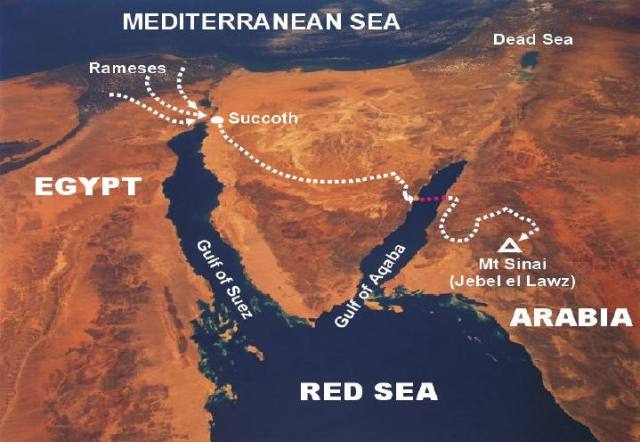
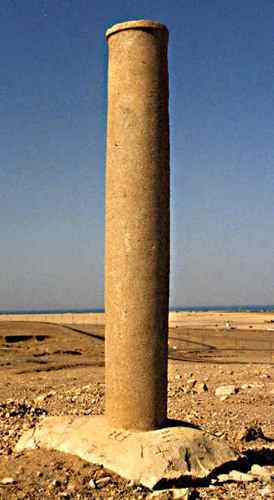

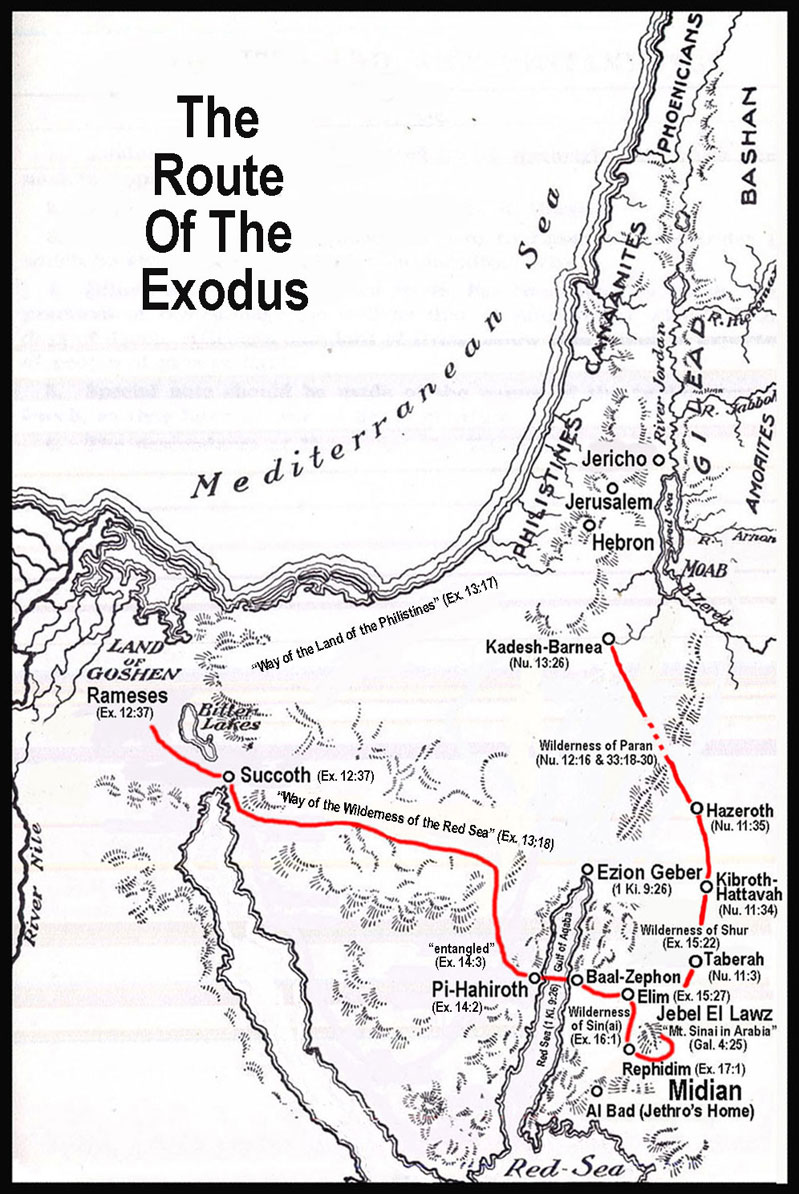
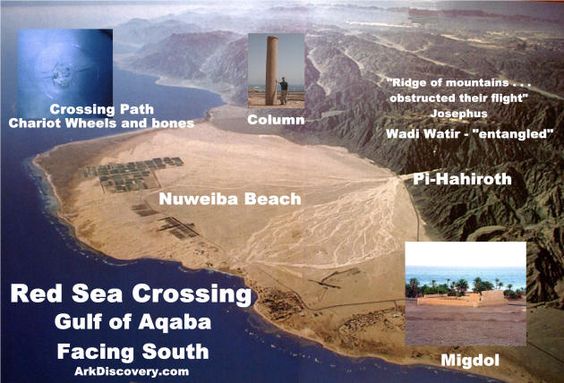



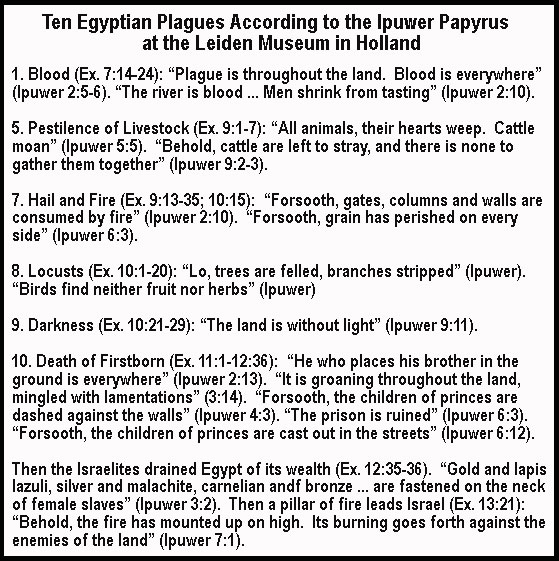
What Was The Route Of The Exodus?
"The children of Israel journeyed from Rameses to Succoth, about six hundred thousand on foot that were men, beside children. And a mixed multitude went up also with them; and flocks, and herds, even very much cattle" (Ex. 12:37-38). From here Israel left on the night of the 15th! (Deut. 16:1). The children of Israel "departed from Rameses in the first month, on the fifteenth day of the first month; on the morrow after the passover the children of Israel went out with an high hand in the sight of all the Egyptians." (Nu. 33:3) Between the morning after the Passover and the next night, "the children of Israel ... borrowed of the Egyptians Jewels of silver, and Jewels of gold, and raiment: And the Lord gave the people favour in the sight of the Egyptians, so that they lent unto them," that is, paid them, "such things as they required. And they spoiled the Egyptians," that is, they took nearly two centuries worth of just wages. Then they gathered at Rameses. Where was this city? Josephus, "Antiquities of the Jews", Book II, Chapter XV says, "So the Hebrews went out of Egypt, while the Egyptians wept, and repented that they had treated them so hardly ... Now they took their journey by Letopolis, a place at that time deserted, but where Babylon was built afterwards, when Cambyses laid Egypt waste." So Rameses was the city of Letopolis, which later under Persian rule, was called the city of Babylon. Smith’s Classical Dictionary of Greek and Roman Biography says of the city of Babylon in Egypt that it "is in later times called Fostat or OLD CAIRO, a fortress in lower Egypt on the right bank of the Nile exactly opposite to the pyramids of Giza, and at the beginning of the canal which connected the Nile with the Red Sea." The city of Rameses, built by the children of Israel in honor of the Pharaoh, was Letopolis, the very city which today the Mohammedans call Old Cairo! God gave the children of Israel the land all the way to the Nile River. The land east of the Nile toward ... Palestine was the land of Goshen. That’s where the cattle of Israel were grazing. The capital city of lower Egypt was Memphis where Pharaoh had his court. The children of Israel, when they assembled in Rameses, were assembling at Old Cairo. Since they reached Rameses or Old Cairo on the night after the Passover, they must have assembled for the Passover a little to the south of Old Cairo -- near Memphis , Pharaoh’s capital. Memphis is on the west side of the Nile . Old Cairo is a little farther north on the east of the Nile River. Memphis is the region where the pyramids were built. Josephus tells us in his "Antiquities of the Jews" (Book II. Chapter IX) that the children of Israel "were forced to channel (make channels for the river), to build walls for the Egyptians and make cities and ramparts .... they set them also to build pyramids (after the pattern of the Great Pyramid), and by all this wore them out ..." Notice a plain statement in the "Imperial Bible Dictionary" (published in England, Volume 5, subject, "Rameses"): "Immediately south of this region of Old Cairo there is an area where there were ancient quarries in a rocky mountain, from which much of the material for the pyramids was procured, and in which the poor Jews are said by Manetho (an Egyptian historian) to have worked." This confirms what Josephus tells us in his work entitled "Apion", Book I, Chapter 26. Near these quarries on the east of the Nile opposite Memphis is an area called "Mera-vad-Musa, or the ‘Habitation (or dwelling) of Moses.’ " Moses was the leader and as he communicated back and forth with Pharaoh it is logical that opposite Memphis, where many of the lesser pyramids were built, Moses should have his headquarters -- to this day bearing the name, "the Habitation of Moses." The "Imperial Bible Dictionary" continues: "From thence (that is, Mera-vad-Musa or the "Habitation of Moses") they moved northward, passing, as Josephus says, by ancient Babylon or Old Cairo, and then by or over the city of modern Cairo, proceeding along the direct route to the land of Canaan, as far as Succoth, or Berket el Hadj, the ‘Pool of the Pilgrims’ ..." "Succoth" merely means booths -- or an encampment. It was there Moslem pilgrims, to this day, can go from Egypt over to Mecca, the holy city of the Mohammedan religion.
Israel travelled "through the way of the wilderness of the Red Sea " (across Sinai Desert -- Ex. 13:18) from Succoth to the Red Sea (Gulf of Aqaba defined as Yam Suph or Red Sea in 1 Ki. 9:26 because Elot is present day Eilat). Isaiah 51:10 calls it "the great deep" and "depths of the sea" so it wasn't just a swampy area or shallow lake that Israel travelled through, even though that western fork of the gulf is also known as the Red Sea (Ex. 10:19).
Instead of bypassing the Red Sea by travelling to Ezion Geber and around, "they turn" (Ex.14:2) south to Pi-hahiroth (literally meaning "Mouth of the Gorges" -- Nuweiba) through the Wadi Watir Valley and became "entangled in the land" and "the wilderness has shut them in" (Ex. 14:3). Steep mountains on both sides as you progress down the Wadi Watir Canyon. Only one way to travel. Then arriving at Nuweiba beach, mountains to the east and the Gulf of Aqaba to the west -- a dead end (Ant. 2:15:4). We know that Esau's son Eliphaz had a son called Zephon. Edom is an area between the Dead Sea and Gulf of Aqaba and further down along its coasts. "Baal-zephon" would therefore be "over against" where the Israelites encamped (Ex. 14:2) meaning on the opposite side of the Gulf of Aqaba. Remarkably, just opposite Nuweiba today a few km. inland in Arabia there is a place called "Saraf-al-Bal" in Arabia ("Zephon" in English is written "Sefon" in other languages.) Moses knew where these places were, since he had lived in "the land of Midian" (Ex. 2:15) during his 40 years of flight. The Sinai Peninsula has always been part of Egypt's sphere of influence. They mined copper and turquoise in the Sinai and had troops garrisoned there. Therefore, Moses fled to Arabia. Midianites settled in the "land of the east" (Gen. 25:5). Keturah's sons settled in Arabia on the Red Sea (Antiquities 2:3:3; 2:11:1; 1:15).
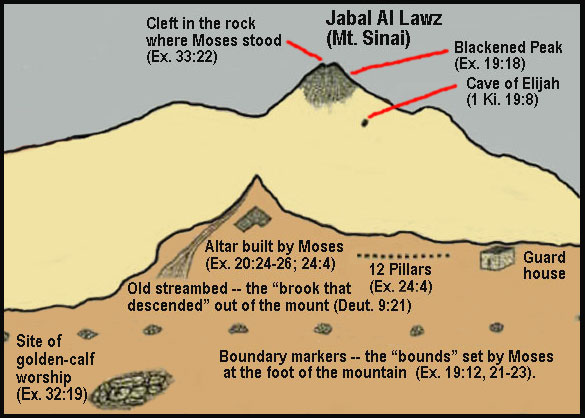
Old maps from 1654 to the present show "Midian" (or Madiana) as located on the east coast of the Gulf of Aqaba. R. F. Burton found a well close to Al Bad. Guided by local bedouins, they called this "the well of Moses." A map from 1719 displays "Grote de Jetro" (Cave of Jethro) on the east coast of the Gulf of Aqaba. Between Nuweiba and Baalzephon there is a flat underwater land bridge with a maximum depth of 240 meters and 2 km. broad and 14 km. long allowing 2 million Israelites to escape. North of this it is 900 meters deep and south of this 1900 meters.
Remarkably, two ancient red granite columns 4.7 meters high and 90 cm in diameter were placed on opposite sides of the Gulf of Aqaba right where this crossing took place (see picture above). Only the Saudi column has been recently removed.
There is a massive split rock on the west side of Jabal al Lawz that shows evidence of gushing water from within. Rocks below are worn smooth by abundant water flow. "Behold, I will stand before you there upon the rock in Horeb; and you shall strike the rock (massive split rock shown above), and there shall come water out of it, that the people may drink. And Moses did so in the sight of the elders of Israel" (Ex. 17:6). "He opened the rock, and the waters gushed out; they ran in the dry places like a river" (Ps. 105:41).


Mount Sinai (Horeb; highest in the area: Ant. 2:12:1) is today "in Arabia" (Gal. 4:25) -- Jabal al Lawz in Saudi Arabia. Exodus 3:12 says, "When thou hast brought forth the people OUT OF EGYPT, ye shall serve God upon this mountain." Therefore Mount Sinai is OUT OF EGYPT. Old maps show a mountain east of Midian in Arabia named "Hagiar" (Chaletain 1719 and R. de Vaugondy 1761). Jabal al Lawz in Arabia is the highest mountain in the region. It stands at 2575 meters, which is 295 meters taller than the traditional Mt. Sinai (Gebel Musa) in the Sinai Peninsula. This mountain's peak is uniquely black (pictured above) because "mount Sinai was altogether on a smoke, because the Lord descended upon it in fire: and the smoke thereof ascended as the smoke of a furnace" (Exodus 19:18-20). Melted rocks from the summit, when broken open, reveal non-volcanic granite inside. "Israel camped before the mount" (Ex. 19:2) in the large plain at the foot of Jabal al Lawz .Further investigation found large piles of rocks in a semicircle around the front of the mountain, spaced about every 400 yards. Measuring about 5 feet tall and 20 feet across, these piles could be the boundary markers placed by Moses. "Put limits around the mountain and set it apart as holy" (Ex. 19:23). In the flat area at the base of the mountain, large boulders were found which had been placed together, creating a formation 30 feet across and 30 feet tall, which could be the altar where the golden calf was constructed. On the rocks were etched ancient drawings of a bull god as described in Exodus 32:4: Aaron "took what they handed him and made...an idol cast in the shape of a calf." Also at the foot of the mountain is a V-shaped altar. Each arm is approximately 60 feet long and 20 feet wide. Next to it are several toppled pillars in sections of about 22 inches in diameter and 20 inches tall. Moses "built an altar at the foot of the other mountain and set up twelve stone pillars representing the twelve tribes of Israel" (Ex. 24:4). High on the mountain is a cave by which Elijah may have stood to hear God's voice. "He reached Horeb, the mountain of God ... and stood at the mouth of the cave" (1 Ki. 19:8,13).
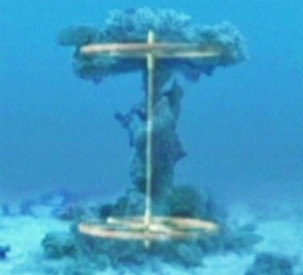


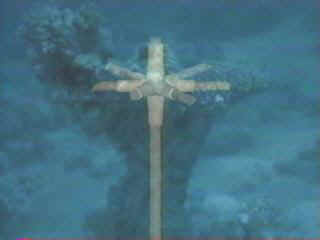
Chariot Wheels Found?
The Egyptian army had "six hundred chosen chariots, and all the chariots of Egypt" (Ex. 14:6-7). Exodus 14:24-25 says, "in the morning watch the LORD looked unto the host of the Egyptians through the pillar of fire and of the cloud, and troubled the host of the Egyptians, And took off their chariot wheels, that they drave them heavily." There are a number of wheels on the underwater bridge with 4, 6, and 8 spokes, including a gold-plated wheel, perhaps from Pharaoh's chariot, with four spokes. The wooden remains of the gold-plated wheel have largely decomposed making it fragile. But coral does not grow on gold, so it is very distinct. War chariots were introduced to Egypt towards the end of the 17th dynasty (Kamosis was last ruler of the 17th dynasty) and the beginning of the 18th (Amosis was first ruler of 18th dynasty). There are a large quantity of skeleton bones on the sea bed at the place of crossing. The fact that some of the remains are petrified indicates they are 3000 years old.
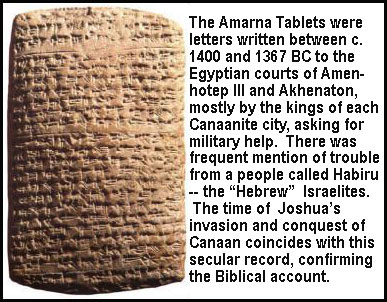
Who was the "Hornet" God Sent?
In Joshua 24:12, it was not merely insects that drove the inhabitants outside their fortified city walls. A HORNET was the hieroglyphic symbol of the united dynasty of upper and lower Egypt. Thutmose III had undertaken 3 campaigns against Canaan. He extorted much wealth, leaving the land in a weakened condition. cp. Ex. 23:28. On Thutmose's helmet was the sign of a hornet. Thutmose III and his chariots destroyed the lowland cities of Canaan (Ashkelon) but the highland cities (Jericho) were not destroyed since Pharaoh's chariots couldn't climb the mountains, so Joshua took those cities.
When Did Jericho Fall?
Joshua 6:20 says, "The wall fell down flat." John Garstang excavated Jericho and found that the walls did actually "fall down flat." Bryant Wood found diagnostic pottery (Cypriotware) on the east side of the tell. He found Egyptian scarabs with dated inscriptions on them giving an unbroken seried extending from 18th century B.C. to 1400 B.C.when the city was destroyed (Israel's conquest). He found remains of a fortified tower. He found storage containers that indicated they had been full of grain at the time the city was "burned" (6:24) (Israelites were commanded not to take anything from Jericho -- 6:18). Consequently, Garstang found under the charcoal and ashes, an abundance of wheat, barley, dates, lentils, etc. turned to charcoal by intense heat. Untouched and uneaten. Joshua 3 mentions that the conquest was "at the time of harvest" (3:15). He exposed the revetment wall at the base of the tell. He found fallen brick from the upper wall piled at the base of the embankment (conveniently making a ramp to conquer the city). One portion of the north wall still remained standing, and had a house built into it with a "window" (2:15) to the outside. Could this be Rahab's house, who was promised that her house would be preserved (2:19)? Joshua 2:15 says, "her house was upon the city wall." Amile away from Jericho is a 1500 foot high ridge called Jebel Kuruntul to which the spies fled (Josh. 2:22).
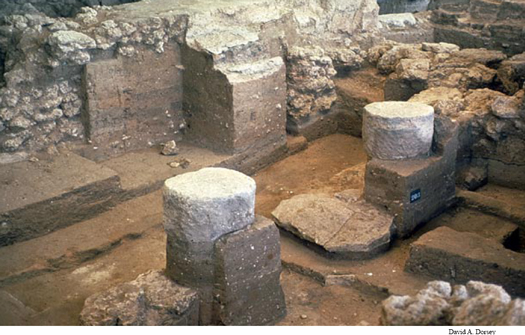
Does Archaeology Shed Any Light on Samson?
Two Philistine temples have been uncovered by archaeologists. One at Tel Qasile, in northern Tel Aviv (above), and one in Tel Miqne, ancient Ekron, 21 miles south of Tel Aviv. Both temples share a unique design—the roof was supported by two central pillars! The pillars were made of wood and rested on stone support bases. With the pillars being about six feet apart, a strong man could dislodge them from their stone bases and bring the entire roof crashing down. The archaeological findings match the Biblical story perfectly and attest to the plausibility of the account.
Did King David Exist?
The Tell Dan inscription found in 1993 just outside the city gate of Dan describes the battle between Hazael, king of Aram, and the kings of Israel and Judah (2 Chr. 22). This inscription was written by the enemy of Israel who mentions that he destroyed the "House of David."
From the tablets found at Mari, we read these clear words: "The year in which Iahdulim went to Hen and laid hands upon the territory of the Benjamites," and "The year that Zimri-Lim killed the DAVIDUM of the Benjamites."
Here are Benjamites mentioned and their generals are called "DAVIDUM" or DAVIDS.
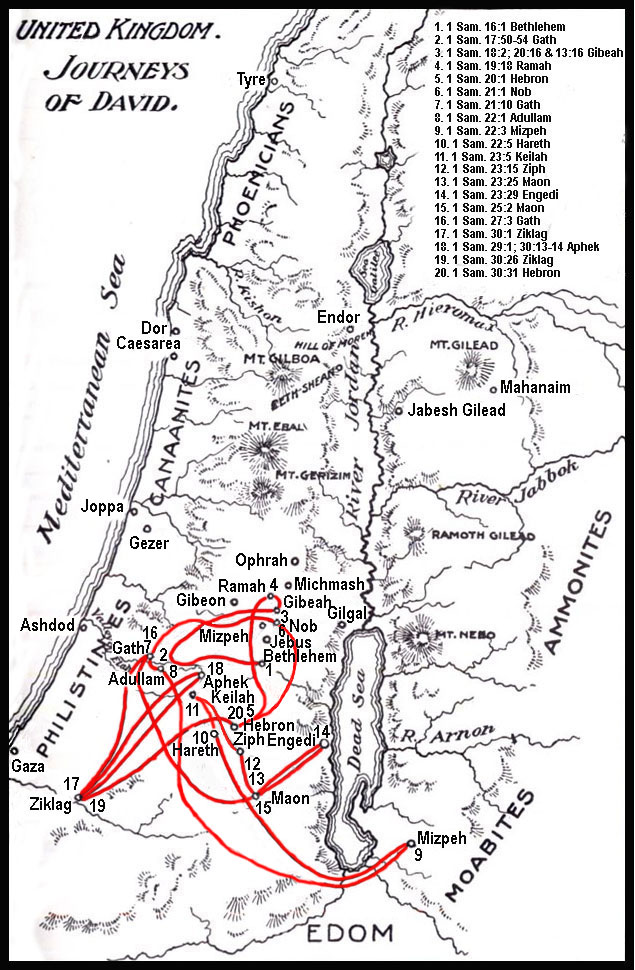
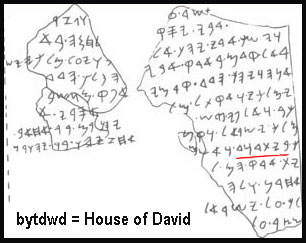

The Mari Letters Mention Hammurabi As Contemporary of King David
The Mari Letters place "Hammurabi" in the 10th Century B.C. rather than the 17th. Amraphel was not Hammurabi (Gen. 14:9). Hammurabi was not a contemporary of Abraham. According to the King List of the First Dynasty of Babylon, he ruled from Babylon for 55 years from 1072-1017 BC. Hammurabi's contemporaries include the "Davidum of the Benjamites". These "Benjamiites are not well disposed to the idea of a census" nor are their kinsmen the Reubenites. Shamsi-Adad is equated with Hadadezer. Both are said to have employed 20,000 troops (1 Chr. 18:4). Zimri-Lim is equated with Resin king of Syria whose father was Eliada (1 Ki. 11:23) corresponding to Zimri-Lim's father Iahdulim/Yahdu-Lim. These similarities are striking, and illustrate the fact that Hammurabi lived AFTER Moses, not before (cp. Werner Keller's Bible as History pp. 49-52). Moses came first. God's law was the basis of Babylonian Law. God's law was the basis of the Code of Hammurabi. Not the other way around. The same is also true of Babylonian proverb literature which resulted from King Solomon's influence on surrounding cultures after Hammurabi. The same is also true of the Babylonian accounts of creation and the flood. They came AFTER the Bible account, not before. The Babylonian dynasties of king lists were not successive, but instead many were contemporary of one another. Parallel dynasties are very troublesome facts for Babylonian chronologists.
Naval Wisdom in the Psalms & Ecclesiastes
Dr Matthew Maury was in charge of the Depot of Charts and Instruments in the Hydrographic Office of the United States Navy from 1841-1861. He was aware of Psa 8:8 - “the paths of the seas" and Ecc 1:6 - “The wind goeth toward the south, and turneth about unto the north; it whirleth about continually, and the wind returneth again according to his circuits.” Maury reasoned that if these wind and ocean currents could be located and plotted, this information would be of great value to marine navigators. Utilising this information, the sailing vessels could be directed along routes that would take advantage of these sea and air currents, significantly reducing time required to traverse the seas. Maury found and plotted the wind and ocean currents. The great Gulf Current - 40 miles wide and 2000 feet deep flowing from the Gulf of Mexico up through the Atlantic has a significant influence on the climate of England, Ireland, Europe, and the Scandinavian countries!
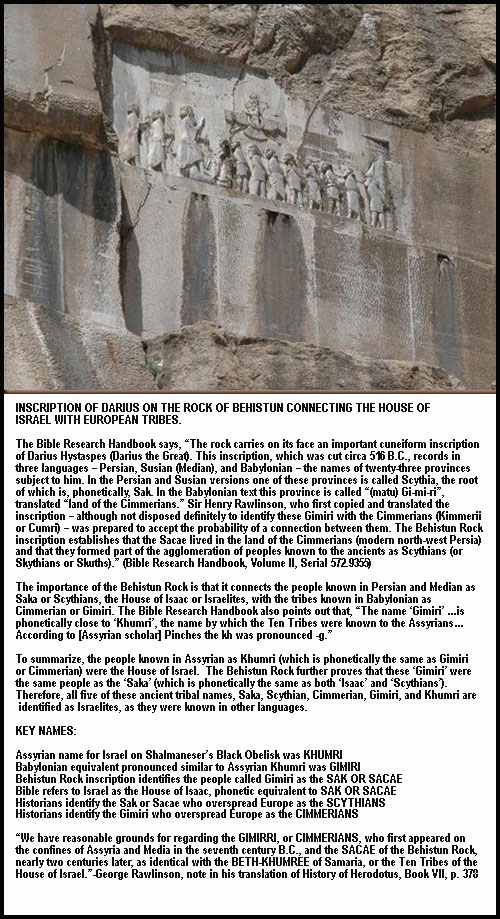
Isaiah's Prophecy of Cyrus Confirmed
Cyrus, King of the Medo-Persian Empire, is among the most important foreign rulers of the Israelite nation. In fact, many Old Testament prophecies revolve around this monarch. The prophet Isaiah documented that the Babylonian Empire would fall to the Medes and the Persians (Isaiah 13; 21:1-10). Not only did Isaiah detail the particular empire to which the Babylonians would fall, but he also called Cyrus by name (Isaiah 44:28; 45:1-5). Amazingly, Isaiah’s prophecy was made roughly 150 years before Cyrus was born (Isaiah prophesied in about 700 B.C.; Cyrus took the city of Babylon in 539 B.C.). To add to Cyrus’ significance, Isaiah predicted that Cyrus would act as the Lord’s “shepherd.” In fact, Isaiah recorded these words of the Lord concerning Cyrus: “And he shall perform all My pleasure, even saying to Jerusalem, ‘You shall be built,’ and to the temple, ‘Your foundation shall be laid’ ” (Isaiah 44:28).
In 1879, Hormoz Rasam found a small clay cylinder (about nine inches long, and now residing in the British Museum) in the ancient city of Babylon. Upon the clay cylinder, King Cyrus had inscribed, among other things, his victory over the city of Babylon and his policy toward the nations he had captured, as well as his policy toward their various gods and religions. Price recorded a translation of a segment of the cuneiform text found on the cylinder:
...I returned to [these] sacred cities on the other side of the Tigris, the sanctuaries of which have been in ruins for a long time, the images which [used] to live therein and established for them permanent sanctuaries. I [also] gathered all their [former] inhabitants and returned [to them] their habitations. Furthermore, I resettled upon the command of Marduk the great lord, all the gods of Sumer and Akkad whom Nabonidus has brought into Babylon to the anger of the lord of the gods, unharmed, in their [former] chapels, the places which made them happy. May all the gods who I have resettled in their sacred cities ask daily Bel and Nebo for long life for me and may they recommend me...to Marduk, my lord, may they say thus: Cyrus, the king who worships you and Cambyses, his son, [...] all of them I settled in a peaceful place (pp. 251-252).
The policy, often hailed as Cyrus’ declaration of human rights, coincides with the biblical account of the ruler’s actions, in which Cyrus decreed that the temple in Jerusalem should be rebuilt, and that all the exiled Israelites who wished to join in the venture had his permission and blessing to do so (Ezra 1:1-11). The little nine-inch-long clay cylinder stands as impressive testimony—along with several other archaeological finds—to the historical accuracy of the biblical text.
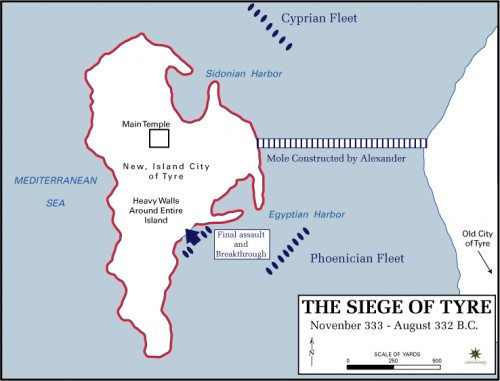
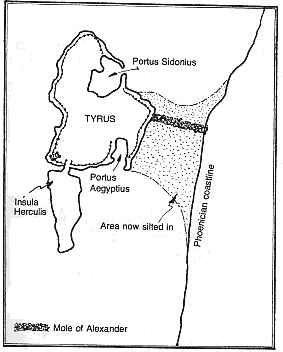

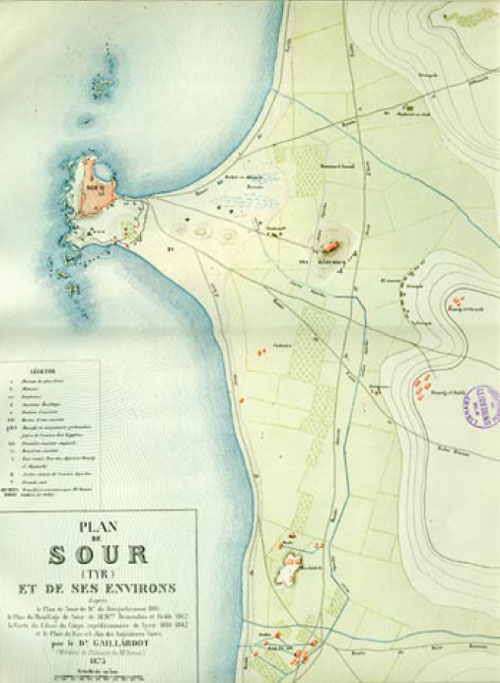
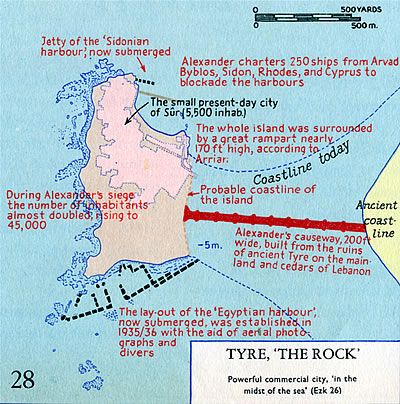
Ezekiel's Prophecy of Tyre Confirmed
The date of the Tyre prophecy is the eleventh year after 597 which was 586 B.C. About half a mile off the eastern shore of the Mediterranean Sea stood a small rocky island on which the original city of Tyre was most likely founded. Some time after the founding of this island city, the mainland city of Tyre was founded, which was called Old Tyre by the Greeks (Fleming, Wallace B. (1966), The History of Tyre (New York, NY: AMS Press, p.4). “Because Tyre has said against Jerusalem, ‘Aha! She is broken who was the gateway of the peoples; now she is turned over to me; I shall be filled; she is laid waste.’ Therefore thus says the Lord God: ‘Behold, I am against you, O Tyre’” (26:2-3). Apparently, in an attitude of commercial jealousy and greed, the city of Tyre exulted in Jerusalem’s misfortunes and expected to turn them into its own profit. The prophet Joel noted that Tyre had taken the people from Judah and Jerusalem and sold them to the Greeks so that the Tyrians could “remove them far from their borders” (Joel 3:6). Therefore thus says the Lord God: “Behold, I am against you, O Tyre, and will cause many nations to come up against you, as the sea causes its waves to come up. And they shall destroy the walls of Tyre and break down her towers; I will also scrape her dust from her, and make her like the top of a rock. It shall be a place for spreading nets in the midst of the sea, for I have spoken,” says the Lord God; “it shall become plunder for the nations. Also her daughter villages which are in the fields shall be slain by the sword. Then they shall know that I am the Lord.”
For thus says the Lord God: “Behold, I will bring against Tyre from the north Nebuchadnezzar king of Babylon, king of kings, with horses, with chariots, and with horsemen, and an army with many people. He will slay with the sword your daughter villages in the fields; he will heap up a siege mound against you, build a wall against you, and raise a defense against you. He will direct his battering rams against your walls, and with his axes he will break down your towers. Because of the abundance of his horses, their dust will cover you; your walls will shake at the noise of the horsemen, the wagons, and the chariots, when he enters your gates, as men enter a city that has been breached. With the hooves of his horses he will trample all your streets; he will slay your people by the sword, and your strong pillars will fall to the ground.
They will plunder your riches and pillage your merchandise; they will break down your walls and destroy your pleasant houses; they will lay your stones, your timber, and your soil in the midst of the water. I will put an end to the sound of your songs, and the sound of your harps shall be heard no more. I will make you like the top of a rock; you shall be a place for spreading nets, and you shall never be rebuilt, for I the Lord have spoken,” says the Lord God.
For thus says the Lord God: “When I make you a desolate city, like cities that are not inhabited, when I bring the deep upon you, and great waters cover you, then I will bring you down with those who descend into the Pit, to the people of old, and I will make you dwell in the lowest part of the earth, in places desolate from antiquity, with those who go down to the Pit, so that you may never be inhabited; and I shall establish glory in the land of the living. I will make you a terror, and you shall be no more; though you are sought for, you will never be found again,” says the Lord God (Ez. 26:1-14,19-21).
The prophet predicted: (1) many nations would come against Tyre; (2) the inhabitants of the villages and fields of Tyre would be slain; (3) Nebuchadnezzar would build a siege mound against the city; (4) the city would be broken down and the stones, timber, and soil would be thrown in “the midst of the water;” (5) the city would become a “place for spreading nets;” and (6) the city would never be rebuilt.
In chronological order, the siege of Nebuchadnezzar took place within a few months of Ezekiel’s prophecy. "Nebuchadnezzar took all Palestine and Syria and the cities on the seacoast, including Tyre, which fell after a siege of 13 years (573 B.C.)" (E. A. Wallis Budge, Babylonian Life And History, p. 50). Josephus asserts, upon the authority of the Phenician Annals, translated by Menander, the Ephesian, into Greek, “that Nebuchadnezzar besieged Tyre thirteen years, when Ithobal was king there, and began the siege in the seventh year of Ithobal’s reign, and that he subdued Syria and all Phenicia" (Against Apion, 1.21). That is 586 to 573 B.C. The length of the siege was due, in part, to the unusual arrangement of the mainland city and the island city. While the mainland city would have been susceptible to ordinary siege tactics, the island city would have been easily defended against orthodox siege methods (Fleming, p. 45). The historical record suggests that Nebuchadnezzar destroyed the mainland city, but the siege of the island “probably ended with the nominal submission of the city” in which Tyre surrendered “without receiving the hostile army within her walls” (p. 45). The city of Tyre was besieged by Nebuchadnezzar, who did major damage to the mainland as Ezekiel predicted, but the island city remained primarily unaffected.
Ezekiel began his prophecy by stating that “many nations” would come against Tyre (26:3). Then he proceeded to name Nebuchadnezzar, and stated that “he” would build a siege mound, “he” would slay with the sword, and “he” would do numerous other things (26:7-11). However, in 26:12, the pronoun shifts from the singular “he” to the plural “they.” It is in verse 12 and following that Ezekiel predicts that “they” will lay the stones and building material of Tyre in the “midst of the waters.” The shift in pronouns is of vast significance, since it shifts the subject of the action from Nebuchadnezzar (he) back to the many nations (they).
Regarding the prediction that “many nations” would come against Tyre, history records the following: After Nebuchadnezzar’s attack of the city “a period of great depression” plagued the city which was assimilated into the Persian Empire around 538 B.C. (Fleming, p. 47). In 392 B.C., “Tyre was involved in the war which arose between the Persians and Evagorus of Cyprus” in which the king of Egypt “took Tyre by assault” (p. 52). Sixty years later, in 332, Alexander the Great besieged Tyre and crushed it (see below for further elaboration). Soon after this defeat, Ptolemy of Egypt conquered and subjugated Tyre until about 315 B.C. when Atigonus of Syria besieged Tyre for 15 months and captured it (Fleming, p. 65). In fact, Tyre was contested by so many foreign forces that Fleming wrote: “It seemed ever the fate of the Phoenician cities to be between an upper and a nether millstone” (p. 66). Babylon, Syria, Egypt, Rome, Greece, Armenia, and Persia are but a sampling of the “many nations” that had a part in the ultimate destruction of Tyre. Thus, Ezekiel’s prophecy about “many nations” remains as a historical reality that cannot be successfully gainsaid.
Ancient historian Diodorus Siculus, who lived from approximately 80-20 B.C., wrote extensively of the young Greek conqueror’s dealing with Tyre. It is from his original work that much of the following information on Tyre’s destruction derives (see Siculus, 1963, 17.40-46).
In his dealings with Tyre, Alexander asserted that he wished to make a personal sacrifice in the temple of Heracles on the island city of Tyre. Apparently, because the Tyrians considered their island refuge virtually impregnable, with war machines covering the walls, and rapidly moving water acting as an effective barrier from land attack, they refused his request. Upon receiving their refusal, Alexander immediately set to work on a plan to besiege and conquer the city. He set upon the task of building a land bridge or cause way (Siculus calls it a “mole”) from the mainland city of Tyre to the island city. Siculus stated: “Immediately he demolished what was called Old Tyre and set many tens of thousands of men to work carrying stones to construct a mole” (17.40). Curtius Rufus noted: “Large quantities of rock were available, furnished by old Tyre” (4.2.18) Rufus, Quintus Curtius (2001), The History of Alexander, trans. John Yardley (New York, NY: Penguin). This unprecedented action took the Tyrians by complete surprise. Fleming noted: “In former times the city had shown herself well nigh impregnable. That Alexander’s method of attack was not anticipated is not strange, for there was no precedent for it in the annals of warfare” (p. 56). The mainland city was demolished and all her stones, timber, and soil were thrown into the midst of the sea.
In spite of the fact that the Tyrians were taken by surprise, they were not disheartened, because they did not believe that Alexander’s efforts would prevail. They continued to maintain supremacy on the sea, and harassed his workers from all sides from boats that were equipped with catapults, slingers, and archers. These tactics were effective in killing many of Alexander’s men. But Alexander was not to be outdone. He gathered his own fleet of ships from nearby cities and was successful in neutralizing the Tyrian vessels’ effectiveness.
With the arrival of Alexander’s sea fleet, the work on the land bridge moved much more rapidly. Yet, when the construction of the bridge was nearing completion, a storm damaged a large section of the mole. Refusing to quit, Alexander rebuilt the damaged structure and continued to move forward. In desperation, the Tyrians sent underwater divers to impede construction by attaching hooks to the rocks and trees of the causeway, causing much damage (Rufus, 4.3.10). Yet, these efforts by the Tyrians could not stop Alexander’s army and eventually the bridge spanned the distance from the mainland city to the island. Huge siege machines bombarded the walls of Tyre. Siculus’ description of the fight is one of the most vivid accounts of a battle in ancient history (17.43-46).
Eventually the Tyrians were defeated, their walls penetrated, and Alexander’s forces entered the city and devastated it. Most of the men of Tyre were killed in continued fighting. Siculus recorded that approximately 2,000 of the men in Tyre who were of military age were crucified, and about 13,000 “non-combatants” were sold into slavery (17.46) [Others estimate the number even higher.] In describing the devastation of the city by Alexander, Fleming wrote: “There was general slaughter in the streets and square. The Macedonians were enraged by the stubborn resistance of the city and especially by the recent murder of some of their countrymen; they therefore showed no mercy. A large part of the city was burned” (p. 63).
One of the most disputed aspects concerning Ezekiel’s prophecy is the statement that the city of Tyre would “never be rebuilt” (26:14), and “be no more forever” (28:19). The skeptic points to modern day Tyre on a map and claims the Bible is wrong.
But it is clear from the ancient and modern coastlines of the island (see above), that the southern section of the island of Tyre is UNDER WATER today. Later earthquakes caused this area to SLIP INTO THE SEA. But the line of rocks still poking above the water marks where the ancient walls of the city once stood. In approximately A.D. 1170, a Jewish traveler named Benjamin of Tudela published a diary of his travels. “Benjamin began his journey from Saragossa, around the year 1160 and over the course of thirteen years visited over 300 cities in a wide range of places including Greece, Syria, Palestine, Mesopotamia and Persia” (Benjamin of Tudela, n.d.). In his memoirs, a section is included concerning the city of Tyre.
From Sidon it is half a day’s journey to Sarepta (Sarfend), which belongs to Sidon. Thence it is a half-day to New Tyre (Sur), which is a very fine city, with a harbour in its midst.... There is no harbour like this in the whole world. Tyre is a beautiful city.... In the vicinity is found sugar of a high class, for men plant it here, and people come from all lands to buy it. A man can ascend the walls of New Tyre and see ancient Tyre, WHICH THE SEA HAS NOW COVERED, lying at a stone’s throw from the new city. And should one care to go forth BY BOAT, one can see the CASTLES, MARKET-PLACES, STREETS, and PALACES IN THE BED OF THE SEA (1907, emp. added.).
"But as for the island city, it apparently SANK BELOW the surface of the Mediterranean…All that remains of it is a series of BLACK REEFS offshore from Tyre, which surely could not have been there in the first and second millennia b.c., since they pose such a threat to navigation. The promontory that now juts out from the coastline probably was washed up along the barrier of Alexander’s causeway, but the island itself broke off and SANK AWAY when the subsidence took place; and we have no evidence at all that it ever was built up again after Alexander’s terrible act of vengeance. In the light of these data, then, the predictions of chapter 26, improbable though they must have seemed in Ezekiel’s time, were duly fulfilled to the letter—first by Nebuchadnezzar in the sixth century, and then by Alexander in the fourth." (Archer, “Tyre,” Encyclopedia of Bible Difficulties)
Verse 19 says, "For thus saith the Lord GOD; When I shall make thee a desolate city, like the cities that are not inhabited; when I shall bring UP THE DEEP UPON THEE, and great WATERS SHALL COVER THEE." Many island groups rise and fall in the oceans. If you look at the picture, that island today is missing the southern section at least.
Furthermore, the Island of Tyre was a world power Phoenician city-state. The Island of Tyre was fortified with a double wall that was 150 feet high and 20 feet thick surrounded by a half-mile mote of water. The present fishing village called Sur has no fortifications and is on a peninsula. Second, while it is true that a town does currently exist on the "island" part of the peninsula (Sur), that town is on the north side of the "island" while original Tyre was on the south side. The Temple of Melkart was located in a vast park on the north side anciently. A village of Sur has no real connection to the city condemned by Ezekiel. Third, it could be the case that the bulk of Ezekiel’s prophecy dealt with the mainland city of Tyre, the location of which has most likely been lost permanently and is buried under the waters of the Mediterranean Sea. In his monumental work on the city of Tyre, Katzenstein mentioned several ancient sources that discussed the position of “Old Tyre.” He wrote: “Later this town was dismantled by Alexander the Great in his famous siege of Tyre and disappeared totally with the change of the coastline brought about by the dike and the alluvial deposits that changed Tyre into a peninsula” (1973, p. 15, emp. added).
It very likely is the case that the specific site of ancient Tyre has been buried by sand and water over the course of the last 2,500 years and is lost to modern knowledge. That the prophet was speaking about the mainland city in reference to many aspects of his prophecy has much to commend it. It was to that mainland city that King Nebuchadnezzar directed most of his attention and destructive measures described in Ezekiel 26:8-11. Furthermore, it was the mainland city that Alexander destroyed completely and cast into the sea to build his causeway to the island city. In addition, Katzenstein noted that the scholar H.L. Ginsberg has suggested that the name “Great Tyre” was given to the mainland city, while the island city was designated as “Little Tyre” (p. 20). He further noted 2 Samuel 24:7, which mentions “the stronghold of Tyre,” and commented that this “may refer to “Old Tyre,” or the mainland city (p. 20).
If the history of Tyre is traced more completely, it becomes evident that even the island city of Tyre suffered complete destruction. Fleming noted that in approximately A.D. 193. “Tyre was plundered and burned after a fearful slaughter of her citizens” (1966, p. 73). Around the year 1085, the Egyptians “succeeded in reducing Tyre, which for many years had been practically independent” (p. 85). Again, in about 1098, the Vizier of Egypt “entered the city and massacred a large number of people” (p. 88). In addition, the city was besieged in A.D. 1111 (p. 90), and again in April of 1124 (p. 95). Around the year 1155, the Egyptians entered Tyre, “made a raid with fire and sword...and carried off many prisoners and much plunder” (p. 101).
In addition to the military campaigns against the city, at least two major earthquakes pummeled the city, one of which “ruined the wall surrounding the city” (p. 115). And ultimately, in A.D. 1291, the Sultan Halil massacred the inhabitants of Tyre and subjected the city to utter ruin. “Houses, factories, temples, everything in the city was consigned to the sword, flame and ruin” (p. 122). After this major defeat in 1291, Fleming cites several travel logs in which visitors to the city mention that citizens of the area in 1697 were “only a few poor wretches...subsisting chiefly upon fishing” (p. 124). In 1837, another earthquake pounded the remains of the city so that the streets were filled with debris from fallen houses to such a degree that they were impassable (p. 128).
Taking these events into consideration, it is obvious that many nations continued to come against the island city, that it was destroyed on numerous occasions, and that it became a place for fishing, fulfilling Ezekiel’s prediction about the spreading of nets. Furthermore, it is evident that the multiple periods of destruction and rebuilding of the city have long since buried the Phoenician city that came under the condemnation of Ezekiel. The Columbia Encyclopedia, under its entry for Tyre, noted: “The principal ruins of the city today are those of buildings erected by the Crusaders. There are some Greco-Roman remains, but any left by the Phoenicians lie underneath the present town” (“Tyre,” 2006, emp. added).
Concerning Tyre’s present condition, other sources have noted that “continuous settlement has restricted excavation to the Byzantine and Roman levels and information about the Phoenician town comes only from documentary sources” (“Ancient Tyre...,” n.d., emp. added). Another report confirmed, “Uncovered remains are from the post-Phoenician Greco-Roman, Crusader, Arab and Byzantine times.... Any traces of the Phoenician city were either destroyed long ago or remain buried under today’s city” (“Ancient Phoenicia,” n.d., emp. added).
Daniel's Accuracy Confirmed
Berossus, a Babylonian priest of the 3rd cen. B.C., notes that Nebuchadnezzar after he had reigned 43 years “was suddenly invaded by sickness” (Contra Apionem 1:20). This was the seven-year madness.
The book of Daniel states that Belshazzar was "king" the night that Babylon fell (chap. 5) and says that his "father" was Nebuchadnezzar (5:2, 11, 13, 18). New evidence from Babylon has verified the existence of Belshazzar as well as his co-regency during the absence of his father, Nabonidus, in Temâ. Prior to 1854, he had been an enigma for historians and archeologists who knew nothing of Belshazzar outside the book of Daniel. While the deuterocanonical Book of Baruch (Baruch 1:11, 12) and the writings of Josephus (Antiquities 10.11.2-4 §231-247) do mention Belshazzar, the references to Belshazzar in these works were ultimately dependent on the book of Daniel. Both Xenophon (Cyropaedia, 7.5.28-30) and Herodotus (The Histories, 1.191) recount the fall of Babylon to Cyrus the Great, yet neither of these writers give the name of the king of Babylon. Additionally, both Berossus’ and Ptolemy's king lists have Nabonidus as the last king of Babylon with no mention of Belshazzar.
Then the Nabonidus Cylinder was discovered. Nabonidus petitions the god Sin as follows: "And as for BELSHAZZAR my firstborn son, my own child, let the fear of your great divinity be in his heart, and may he commit no sin; may he enjoy happiness in life". In addition, The Verse Account of Nabonidus (British Museum tablet 38299) states, "[Nabonidus] entrusted the army (?) to his oldest son, his first born, the troops in the country he ordered under his command. He let everything go, entrusted the kingship to him, and, himself, he started out for a long journey. The military forces of Akkad marching with him, he turned to Temâ deep in the west" (Col. II, lines 18 - 29. 18). In line with the statement that Nabonidus "entrusted the kingship" to BELSHAZZAR in his absence, there is evidence that Belshazzar's name was used with his father's in oath formulas, that he was able to pass edicts, lease farmlands, and receive the "royal privilege" to eat the food offered to the gods.
Regarding Belshazzar’s Feast, “until 1853 no mention of Belshazzar was found in the Babylonian records. Nabonidas (555-538 B.C.)was known to have been the last king of Babylon. To the critics this was one of the evidences that the book of Daniel was not historical. But in 1853 an inscription was found in a cornerstone of a temple built by Nabonidas...which read: ‘I, Nabonidas, king of Babylon not sin against thee. And may reverence for thee dwell in the heart of Belshazzar, my first-born favorite son’ From other inscriptions it has been learned that Nabonidas, much of the time, was in retirement outside of Babylon, and that Belshazzar was in control of the army and the government, co-regent with his father, and that it was he who surrendered to Cvrus. This explains how Daniel could be ‘third ruler’ in the kingdom” (Halley’s Bible Handbook, p.144).
Because of Daniel's many accurate prophecies, higher critics have placed Daniel's writing 400 years after the actual time of its writing -- in 168 B.C.. In his Antiquities of the Jews, Josephus relates a story that proves the Book of Daniel existed during the time of Alexander the Great (c. 330 B.C.). Alexander was angry with the Jews for refusing to give him their allegiance. He rode to Jerusalem to punish them as an example. When he arrived, however, a procession of priests, which he had foreseen in a dream in Macedonia, met him. In this dream, God had promised him victory, and for this reason he spared the Jews. Josephus adds that the priests showed Alexander the prophecies in Daniel concerning a Greek conquering the Persian Empire (perhaps Daniel 7:6; 8:3-8,20-22; 11:3). This pleased Alexander, and he treated the Jews with kindness. (Ant. 11:8:5). In another place, Josephus says that there were no other Scriptures added after 424 B.C., the death of Artaxerxes" (Against Apion 1:8). Therefore, the Book of Daniel was not written in 165 B.C., as higher critics contend, but prior to 330 B.C. and prior to 424 B.C.
Cyrus the Great (Cyrus II) was king of Persia from 558 to 529 B.C. He brought the whole of the Near East including mighty Babylon-under his rule, from the Aegean Sea to the Indus River. Significant among his deeds was his granting of permission to the Jewish captives in Babylonia to return to their homeland.
Not only did God call Cyrus by name long before he was born, He also prevented Satan from putting the infant Cyrus to death and thwarting his plan. Greek sources — Herodotus, Xenophon and Ctesias — provide considerable information about Cyrus’ early life. Notice the remarkable story surrounding Cyrus’ birth and childhood, according to a version related by Herodotus in his History (1:107-130):
Astyages, king of the Medes, was overlord of the Persians. Astyages gave his daughter Mandanein marriage to his vassal Cambyses, king of the Persians.
From the marriage of Mandane and Cambyses, Cyrus was born. Astyages, however, had a dream that the baby would grow up to overthrow him. So he ordered his adviser, Harpagus, to personally kill the infant. Harpagus, however, entrusted the execution to a herdsman named Mitradates.
On finding that his wife had just given birth to a stillborn child, the herdsman substituted Cyrus, and reared him as his own son. When Cyrus was 10 years old, Astyages discovered the deception. In spite of the dream, the king was persuaded to let the boy live. When he reached manhood, Cyrus ascended the Persian throne (C. 558 B.C.). In 553 he led a rebellion against his maternal grandfather. In 550 Astyages marched against Cyrus, but his army deserted him and surrendered to the Persians. Astyages — the last ruler of Media — was captured and dethroned, though he was permitted to live out his life in peace. Thus Cyrus became king of the Medes and Persians, firmly established on his throne and poised to fulfill his amazing prophetic destiny
The account of Herodotus ... of the waters of the Euphrates having been diverted by Cyrus, and his troops then entering it while the inhabitants were feasting, confirms Daniel's account.
Xenophon, the Greek historian who wrote the "Cyropaedia" in the fourth century before Christ, says that "when Cyrus reached Babylon" in 539 B.C. he dug channels for the dispersal of the water in the river Euphrates which ran under the gates of Babylon. Then he and the Medo-Persian army secretly entered the river bed, climbed stealthily through the gates along the river and rushed to the palace "when he heard that there was a festival in Babylon, in which all the Babylonians drank and revelled the whole night." Upon reaching the palace where Belshazzar had seen the handwriting on the wall, they "burst in, and, pursuing those who fled, and dealing blows amongst them, came up to the king, and found him in a standing posture with his sword drawn ... [they] mastered him."
Then, when peace had been restored, Cyrus determined to see his father in Persia. "When," wrote Xenophon, "they came to Media, Cyrus turned aside to visit [his uncle] Cyaxares. When they had embraced each other, Cyrus first told Cyaxares that there was a private house, and palaces, set apart for him in Babylon; that when he came thither" -- when Cyaxares would go to Babylon -- "he might take up his abode in his own home."
Who was this Cyaxares? Josephus wrote that he was DARIUS the Mede! ("Antiquities of the Jews," X, 11:4.) DARIUS the Mede, the uncle of Cyrus, "received the kingdom" while Cyrus returned to Persia to see his own father.
History again proves the Bible true. Darius the Mede DID receive the kingdom from Cyrus. It was while Cyrus was with his father in Persia that his uncle Darius WAS "made [TEMPORARY] King over the realm of the Chaldeans"! (Dan. 9:1)
Can We Prove Jesus Was A Real Historical Person Without Using the Bible?
Pliny the Younger (c. 61 - c. 112), the provincial governor of Pontus and Bithynia, wrote to Emperor Trajan c. 112 concerning how to deal with Christians, who refused to worship the emperor, and instead worshiped "Christus": "Those who denied that they were or had been CHRISTIANS, when they invoked the gods in words dictated by me, offered prayer with incense and wine to your image, which I had ordered to be brought for this purpose together with statues of the gods, and moreover cursed CHRIST — none of which those who are really CHRISTIANS, it is said, can be forced to do — these I thought should be discharged. Others named by the informer declared that they were CHRISTIANS, but then denied it, asserting that they had been but had ceased to be, some three years before, others many years, some as much as twenty-five years. They all worshiped your image and the statues of the gods, and cursed CHRIST." (Pliny to Trajan, Letters 10.96–97)
Tacitus (c. 56–c. 117), writing c. 116, included in his Annals a mention of Christianity and "Christus", the Latinized Greek translation of the Hebrew word "Messiah". In describing Nero's persecution of this group following the Great Fire of Rome c. 64, he wrote: "Nero fastened the guilt of starting the blaze and inflicted the most exquisite tortures on a class hated for their abominations, called CHRISTIANS [Chrestians] by the populace. CHRISTUS, from whom the name had its origin, suffered the extreme penalty (crucifixion) during the reign of Tiberius at the hands of one of our procurators, Pontius Pilatus, and a most mischievous superstition, thus checked for the moment, again broke out not only in Judaea, the first source of the evil, but even in Rome, where all things hideous and shameful from every part of the world find their centre and become popular." (Tacitus, Annals 15.44)
Gaius Suetonius Tranquillus (c. 69–140) wrote the following in his Lives of the Twelve Caesars about riots which broke out in the Jewish community in Rome under the emperor Claudius: "As the JEWS were making constant disturbances at the instigation of CHRESTUS, he [Claudius ] expelled them [the Jews] from Rome". (The Life of Claudius 25.4) In Acts 18:2 Luke mentions this expulsion by Claudius. The term Chrestus also appears in some later texts applied to Jesus, and Chrestus is probably a misspelling of Christos, the Greek word for Messiah. Suetonius further commented: “Punishments were also inflicted on the CHRISTIANS, a sect professing a new and mischievous religious belief.” With regard to Jewish persecution around the time to which this passage refers, the Jewish Encyclopedia states: "... in 49–50, in consequence of dissensions among them regarding the arrival of the Messiah, they were forbidden to hold religious services. The leaders in the controversy, and many others of the Jewish citizens, left the city".("Jewish Encyclopedia: Rome: Expelled Under Tiberius"). Suetonius refers to Jews not Christians in this passage, even though in his Life of Nero he shows some knowledge of the sect's existence. One solution to this supposed problem, lies in the fact that the early Christians had not yet separated from their Jewish origin at this time. (Suetonius, Nero 16)
Flavius Josephus (c. 37–c. 100), a Jew and Roman citizen who worked under the patronage of the Flavians, wrote the Antiquities of the Jews in AD 93. In these works, Jesus is mentioned twice, though scholars debate their authenticity. The one directly concerning Jesus has come to be known as the Testimonium Flavianum, and states: "About this time came JESUS, a wise man, if indeed it is appropriate to call him a man. For he was a performer of paradoxical feats, a teacher of people who accept the unusual with pleasure, and he won over many of the Jews and also many Greeks. He was the CHRIST. When Pilate, upon the accusation of the first men amongst us, condemned him to be crucified, those who had formerly loved him did not cease to follow him, for he appeared to them on the third day, living again, as the divine prophets foretold, along with a myriad of other marvellous things concerning him. And the tribe of the CHRISTIANS, so named after him, has not disappeared to this day." (Josephus Antiquities 18.3.3) In the second, brief mention, Josephus calls James "the brother of JESUS, who was called CHRIST." (Josephus Antiquities 20:9.1) Josephus calls John the Baptist "the good man" (Antiquities of the Jews, 18:5, 2).
Mara was a Syrian Stoic. While imprisoned by the Romans, Mara wrote a letter to his son that includes the following text: "For what benefit did the Athenians obtain by putting Socrates to death, seeing that they received as retribution for it famine and pestilence? Or the people of Samos by the burning of Pythagoras, seeing that in one hour the whole of their country was covered with sand? Or the Jews by the murder of their WISE KING, seeing that from that very time their kingdom was driven away from them? For with justice did God grant a recompense to the wisdom of all three of them. For the Athenians died by famine; and the people of Samos were covered by the sea without remedy; and the Jews, brought to desolation and expelled from their kingdom, are driven away into every land. Nay, Socrates did “not” die, because of Plato; nor yet Pythagoras, because of the statue of Hera; nor yet the WISE KING, because of the new laws which he enacted." (Theissen, Gerd and Annette Merz. The historical Jesus: a comprehensive guide. Fortress Press. 1998. translated from German (1996 edition)). Composed sometime between 73 AD and the 3rd century, some scholars believe this describes the fall of Jerusalem as the gods' punishment for the Jews having killed Jesus because they infer that Jesus must be "the wise king" referred to by Mara.
The Babylonian Talmud in many instances refers to Jesus using the terms "Yeshu," "Yeshu ha-Notzri," "ben Satda," "that man," "dead dog," "the hanged one," "sorcerer," "Balaam," "Seducer," and "ben Pandera". These references probably date back to the Tannaitic period (70–200 CE) and have been known in detail by many scholars. Jesus Christ is never mentioned by name, excepting perhaps once or twice, where He is said to have been an idolator who worshipped a brickbat (Sanh., 107B). One important reference relates the trial and execution of Jesus and his disciples. It includes this text: "It is taught: On the eve of Passover they hung YESHU and the crier went forth for forty days beforehand declaring that "[Yeshu] is going to be stoned for practicing witchcraft, for enticing and leading Israel astray. Anyone who knows something to clear him should come forth and exonerate him." But no one had anything exonerating for him and they hung him on the eve of Passover. Ulla said: Would one think that we should look for exonerating evidence for him? He was an enticer and God said (Deuteronomy 13:9) "Show him no pity or compassion, and do not shield him." YESHU was different because he was close to the government." (b Sanhedrin 43a). The Jewish Encyclopedia tabulates the places where Jesus is mentioned in the Talmud. This encyclopedia terms as a mere "subterfuge" the attempt of atheists to run from these references which apply to Jesus of Nazareth. Jesus is called, in the Talmud, "Son of Pandera" at times to hide the fact that He was born of a young virgin. "Pandera" -- a word meaning panther or leopard -- is an anagram (a word made by transposing letters) for the Greek word "parthenos" meaning "virgin". The Jews twisted Jesus' virgin birth to make it appear that He was figuratively the son of a panther or leopard -- for the Greek word "panther" is PANTHER which the Jews corrupted by Jewish idiom into PANDERA. The miracles of Jesus were not denied by the Jews. Instead, Jews who saw Jesus perform these miracles said he learned sorcery in Egypt -- which is merely another way of stating Matthew 12:24: "But when the Pharisees heard it, they said, This man cloth not cast out demons but by Beelzebub, prince of the demons." The Talmud records Jesus' healing of the blind, the halt and the leprous. It also mentions His walking on the sea! There is also a full list of references to Jesus' mother, the virgin Mary. These events are therefore here proved to be historical fact -- they are recorded by Jesus' own enemies! 'You are doing the things your own father does.' 'We are not illegitimate children,' they protested. 'The only Father we have is God himself'...The Jews answered him, 'Aren't we right in saying that you are a Samaritan and demon-possessed?' " (Joh 8:41,48; cp Joh 9:29). (The use of the term "Samaritan" is their thinly-veiled suggestion of illegitimacy, since the Samaritans were a mixed race, part Jew and part Gentile.) The Talmud subtly calls the gospel which Jesus preached an "avengil", meaning a "blank paper." They did not want to use the original word "evangel", meaning good news. They did not like the good news of the Kingdom which Jesus brought. They did not want the Kingdom of God to rule over them -- to tell them what to do!
Lucian of Samosata said, "The CHRISTIANS, you know, worship a man to this day — the distinguished personage who introduced their novel rites, and was crucified on that account… You see, these misguided creatures start with the general conviction that they are immortal for all time, which explains the contempt of death and voluntary self-devotion which are so common among them; and then it was impressed on them by their original lawgiver that they are all brothers, from the moment that they are converted, and deny the gods of Greece, and worship the crucified SAGE, and live after his laws.( Lucian, The Death of Peregrine, 11–13 in The Works of Lucian of Samosata, translated by H. W. Fowler (Oxford: Clarendon, 1949) vol. 4)
Celsus wrote, about 180, a book against the Christians, which is now only known through Origen's refutation of it. Celsus apparently accused Jesus of being a magician and a sorcerer and is quoted as saying that Jesus was a "mere man".
Can You Trust the Bible?
Jesus said: "Till heaven and earth pass, one jot or one tittle shall in no wise pass from the law till all be fulfilled" (Matthew 5:18). "Heaven and earth shall pass away,, but my words shall not pass away" (Matt. 24:35). The Dead Sea Scrolls have confirmed the accuracy of the Old Testament scriptures. Luke quotes Jesus as saying: "And it is easier for heaven and earth to pass, than one tittle of the law to fail" (Luke 16:17). Modern critics assume Jesus was wrong. To whom were the Scriptures, the inspired words of God in the Old Testament, given to preserve? "What advantage, then, hath the Jew? ... Much every way, chiefly because unto them were committed the oracles of God" (Rom. 3:1-2).